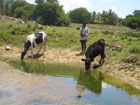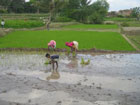Why Rainwater Harvesting?
"Are we condemned to be largely spectators? Can we affect the course of events? Can we claim 'compassion fatigue' when we show no sign of consumption fatigue?"
—Sebastião Salgado
- Water availability per capita has been on the decline in India. Two reasons have been the increasing demand for water and the increasing population.The quantum of water available to the country being fixed the increasing demand reduces per capita water availability.
- Agriculture continues to be the single largest consumer of water however industrial demand for water shows the fastest growth. Especially South India and in particular Karnataka is a drought prone region. The state enjoys the dubious distinction of having the second largest area prone to drought next only to Rajasthan.
- Bangalore gets most of its drinking water from a distance of 95 kms. and a depth of 500 mts.
- It makes ecological and financial sense not to waste a pure natural resource available in large quantity on one’s roof.
- In the case of a homebuilder, at an initial stage of construction, investments in time, design and money are minimal for adopting roof rainwater harvesting.
- Ground water sources are increasingly getting depleted or are getting polluted. Borewells are either silting up, getting short of water or are drawing polluted water.
- Private purchase of water from tankers is unreliable in quality and is also expensive.
- It encourages water conservation and self-dependence.
- it is being recognized that people from various sectors have to become partners in the solution process and not remain simply as institutional beneficiaries.
- India is blessed with adequate rainfall as a whole, yet there are large swathes of dry, drought prone area. In many other places the quality of groundwater is not good. In such places rainwater harvesting can provide lifeline water for survival and more.
Potential for rainwater harvesting:
- One acre of land in Bangalore for example, with about 900 mm of rain receives nearly 36 lakh litres of water as endowment. A small 100 square metre of roof area would receive 90,000 litres of rainwater in an average year of rain.
- You can calculate what is the potential of rainwater harvesting in your area and have one appropriate for you.
- Rainwater harvesting has tremendous potential and it is up to each one of us to push this technique further for a sustainable water situation for India.


